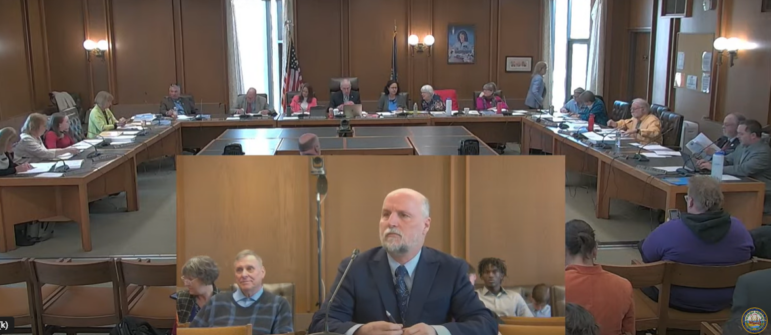Power to the People is a column by D. Maurice Kreis, New Hampshire’s Consumer Advocate. Kreis and his staff of four represent the interests of residential utility customers before the NH Public Utilities Commission and elsewhere. It is co-published by Manchester Ink Link and InDepthNH.org.
D. MAURICE KREIS, Power to the People
New York State’s Tappan Zee Bridge has long been one of my favorite crossings. When I was a little kid, growing up nearby, I somehow got the idea that this three-mile double-curved span across the Hudson River was named after two other little kids, Tap and Zee.
Recently New York replaced the rusty old Tappan Zee Bridge with a new double edition, substituting the clunky cantilevered span across the shipping channel portion of the river with a majestic and sculptural pair of cable-stayed crossings. I know a good bridge replacement project when I see one.
That’s why I was so pleased to learn that Liberty Utilities has scrapped its $400 million-plus Granite Bridge project with a new edition that is better and cheaper.
As originally proposed more than two years ago, Granite Bridge involved the construction of a 16-inch pipeline along Route 101 between the seacoast and Manchester along with a huge tank (two billion cubic feet huge, in fact) for storing liquefied natural gas in Epping. Some activists hated it. We opposed it.
Our dislike, here at the Office of the Consumer Advocate, was different than that of the climate activists. They contend that any construction of new facilities to move, to store, or even to deliver natural gas to customers must not happen because burning natural gas contributes unacceptably to global warming.
We respectfully disagree. Natural gas, sold responsibly as a rate-regulated commodity, is compatible with bold climate action. But Granite Bridge was simply too expensive, and too reliant on dreamy estimates of future customer growth, projected too many years into the future.
But, just as the old Tappan Zee Bridge has now been replaced with something better, Granite Bridge is also history. This is very good news for ratepayers.
Essentially, Liberty has taken up the suggestion of John Rosenkranz, the natural gas expert who filed written testimony at the PUC on behalf of the Pipeline Awareness Network of the Northeast (PLAN-NE), a grassroots environmental organization.
“Instead of building the Granite Bridge project, [Liberty] should adopt a more flexible supply strategy that adds new gas supply resources as they are needed,” Rosenkranz testified last September. “One such strategy would be to contract for a smaller amount of new gas transportation service from Tennessee Gas Pipeline, and defer the consideration of a new [liquefied natural gas storage] tank to a later date.”
Which is exactly what Liberty has now decided to do. Call it Granite Bridge 2.0.
When Rosenkranz mentioned Tennessee Gas Pipeline, he was referring specifically to this company’s so-called Concord Lateral, an interstate pipeline that brings gas into New Hampshire via Dracut, Massachusetts and runs parallel to the Merrimack River all the way to Laconia. At various points along the way, the Concord Lateral delivers gas to Liberty for retail sale to customers in places like Nashua, Manchester, Concord, and Tilton.
Granite Bridge 1.0 would have involved an entirely different approach — bringing more gas south from Canada via Maine and then moving it west along Route 101. The additional supply sources would have been nice, but it was an overly expensive strategy.
Now, Tennessee Gas Pipeline has agreed to sell Liberty the additional capacity it needs on the Concord Lateral to meet customer demand over the next few years. And the price tag of Granite Bridge 2.0 is literally an order of magnitude cheaper than Granite Bridge 1.0 was.
How much cheaper? In terms of dollars per dekatherm (a unit of energy commonly used when the topic is natural gas) we’re talking roughly $1.80 for Granite Bridge. The most recent estimate for the new plan, for capacity Liberty was told was not previously available: $0.14 per dekatherm.
You read that right. Fourteen cents vs. $1.80.
My parents raised a cynic. So, naturally, I wondered: If buying more capacity on the Concord Lateral is the cheaper and better plan, why didn’t Liberty propose it in the first place? Was the original Granite Bridge just a scheme to jack up rates via the time-worn utility strategy of buying more toys (i.e., capital assets) and getting them into rate base, with Liberty hoping that nobody would notice there was a more prudent alternative?
Nope, not this time.
Before proposing Granite Bridge, Liberty asked Tennessee Gas Pipeline to sell Liberty more capacity on the Concord Lateral. Tennessee Gas Pipeline refused, saying that extra capacity was simply not available.
Then, somewhere in the last quarter of 2019, in the face of scrutiny from intervenors, the PUC Staff, and the Office of the Consumer Advocate, Liberty rang up Tennessee Gas Pipeline again. This time they said yes.
Why? Danged if I know. Danged if Liberty knows.
Interstate pipeline capacity is sold on an open market, subject to federal oversight. Owners of such interstate facilities, like Tennessee Gas, sell to lots of customers – not just natural gas utilities but also electricity generators like the 720 megawatt Calpine facility in Londonderry. The interstate owners don’t have to tell counterparties like Liberty what they’re up to with their other customers.
Admittedly, the demise of the original Granite Bridge proposal won’t lead to dancing in the streets by activists who believe that anything which expands or even facilitates the continued use of natural gas in New Hampshire is bad and must be stopped. I respect this perspective, given the urgency of the climate crisis, but I respectfully ask the activists to give this latest development the open-minded attention it deserves.
Shutting down the state’s natural gas utilities is not a practical option; too many customers depend on them for energy, particularly during heating season.
At the Office of the Consumer Advocate, our job is to make sure Liberty continues to serve its customers, which in the near term requires them to pursue cost-effective supply opinions. More reliance on electricity reduces carbon emissions, but such “strategic electrification” is best targeted at fuel oil users in the first instance, especially those with no access to natural gas supply. Doing that won’t hold back the deployment of renewable energy.
In the long term, we badger Liberty to think up better ways to serve their heating customers than just furnishing them with gas. We’re thinking of everything from energy efficiency, to switching fuels from gas to electric-powered air source heat pumps, to using decomposing organic matter to produce renewable natural gas, or even to pumping hydrogen through pipeline networks (producing the hydrogen from clean electricity, of course).
For now, we’re just pleased that Liberty won’t build that new pipeline, nor that big storage tank. Yes, there will be some new investments, in the form of upgrades to facilities along the Concord Lateral. But nothing of the magnitude of Granite Bridge.
That just leaves the question of what to call this replacement for Granite Bridge. I have a feeling that Liberty won’t go for Granite Bridge 2.0, just like New York State has sought to name their new span after a now-deceased former governor who shares a last name with the current governor.
But the Tappan Zee Bridge will always be the Tappan Zee Bridge to me, and I’m also sticking with Granite Bridge 2.0. It will remind me of how far we’ve come when it comes to meeting the needs of Liberty’s natural gas customers.





